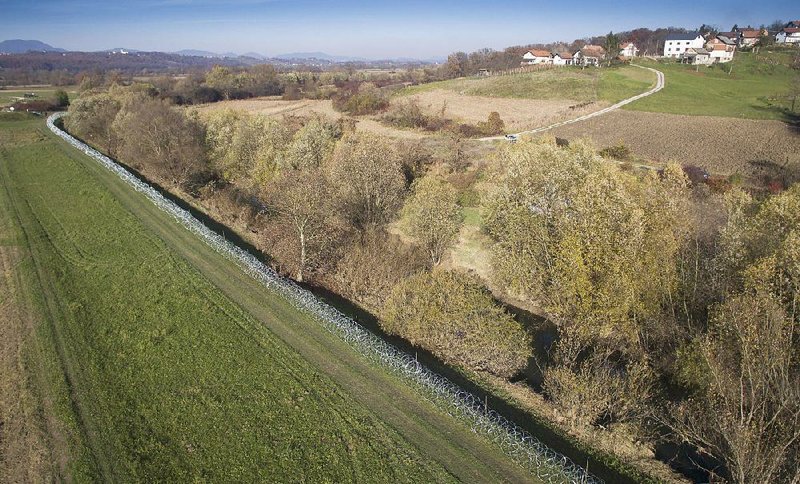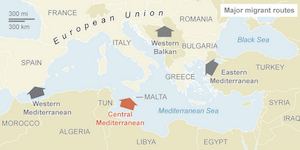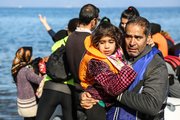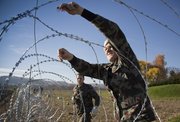VALLETTA, Malta -- The European Union pressed African leaders on Wednesday to take back thousands of people who do not qualify for asylum, holding talks in Malta as Slovenia began building a razor-wire border fence to keep asylum seekers out.
In Sweden, the interior minister said the government would introduce temporary border controls today to stem the flow of migrants to the Scandinavian country.
According to the International Organization for Migration, almost 800,000 people have entered Europe by sea this year. The EU predicts that 3 million more could arrive by 2017.
The Europeans say most Africans are going to Europe in search of work and should be sent home, but many deliberately arrive without documents and must wait months before they are taken back.
In the latest draft of an "Action Plan" to be made public after the summit of 80 African and European leaders in Valletta, the African leaders would commit "to cooperate with the EU on return and admission, notably on travel documentation."
A plan for Africans to be issued with EU documents that would speed extradition was dropped. Migration experts had criticized the plan, saying it shortchanged people's asylum rights.
The president of Niger -- a major transit route for Africans heading to Libya in the hopes of crossing the Mediterranean to Europe -- was cautious about opening the floodgates to returns.
"We are open to talk about it. Everything will depend on the conditions that will be put in place for when they arrive," Mahamadou Issoufou told reporters in Valletta, adding that the best method of solving the migrant crisis is to attack the root causes forcing people to leave in the first place.
"We can put security measures in place, but the flow will remain difficult to stop as long as we don't take measures to reduce poverty," he said.
The EU is working closely with Niger to stem the flow of people toward Libya and, ultimately, Europe. It also is trying to seal deals with Morocco, Tunisia and Egypt. One was signed with Ethiopia as the two-day summit began.
The 28-nation bloc also renewed calls for member countries to contribute hundreds of millions of dollars to a fund to help African nations better manage migration given the tepid response so far.
The European Commission has put $1.9 billion into the "trust fund" and wants EU nations to match that figure.
The deal also promises to double the number of university scholarships for African students and to offer new training opportunities for African entrepreneurs.
The EU's top diplomat at the United Nations, Joao Vale de Almeida, said the deal being proposed was one that African leaders should embrace.
"It is in their interest that we organize a joint response to the challenge," he said in an interview. "The alternative, if they don't engage themselves as well, is we find ourselves in a situation where you would find very little, very little support for any kind of migration.
"It's asking them to help us make that flow a politically sustainable operation," he added.
But the head of the African Union expressed concern that moving on returns too quickly might result in the building of reception centers where people are held until they can be granted asylum or be sent home.
Such centers, "whatever we call them, will become de-facto detention centers," African Union Chairman Nkosazana Dlamini Zuma said.
She warned that women and children would be in danger if held there, and she also pointed at some European countries that "have taken a fortress approach" to migration.
Slovenia-Croatia Dispute
In Slovenia, army trucks carrying fencing and bulldozers arrived Wednesday in Veliki Obrez and soldiers began unwinding the spirals of wire and stretching them along the Slovenian side of the Sutla River that divides the country from Croatia. Other units were later seen with fencing farther southwest, near the town of Gibina.
Tensions later mounted on the Slovenia-Croatia border, with Croatian authorities saying parts of the fence were being put up in disputed territory. Journalists saw Croatian police demand that Slovenia take down a section of the fence.
Croatian special forces arrived at the Harmica border crossing, while Slovenian special police stood armed on the Slovenian side. A helicopter flew above illuminating the area with a spotlight before the Croatian forces pulled back.
Croatia authorities claim that the Slovenian fence has entered Croatian territory in seven locations and want it removed.
Slovenia denies any part of the fence is on Croatian soil. Both countries are locked in a dispute over certain parts of their territory after the breakup of Yugoslavia in the 1990s.
Earlier, Slovenian Foreign Minister Karl Erjavec informed Austrian authorities in Vienna that the razor-wire fence would be 50 miles long, according to the Austrian Press Agency.
Slovenian Prime Minister Miro Cerar said his country expects about 30,000 new migrants to reach its borders. His government fears that if neighboring Austria restricts entry, the thousands stranded in Slovenia would be too much for the tiny Alpine state to handle.
"If we don't act on time," Cerar said, "this could cause a humanitarian catastrophe on the territory of Slovenia."
He said the barrier will be used to direct the refugee flow, not to close the 400-mile border, as was the case in Hungary when it put up border fences.
Nearly 170,000 migrants have crossed into Slovenia since mid-October, when Hungary closed its border with Croatia and the flow of desperate people heading to western Europe was redirected to Slovenia.
In Sweden, Interior Minister Anders Ygeman said the border controls will be introduced early today in Stockholm and last until Nov. 21.
Sweden says migration authorities are overstretched and nearly 200,000 asylum seekers are expected this year. Sweden has a population of 9.7 million.
It wasn't immediately clear whether the move would allow Sweden to turn people away at the border. But it would hinder people from transiting through the country to reach neighboring Finland and Norway.
Migrants arriving at the border would have to decide whether to apply for asylum in Sweden or to turn around, Ygeman said. Most migrants are traveling to Sweden by boat from Germany or across the Oresund bridge from Denmark.
He said the move was a way to "bring order" to the Swedish asylum system while sending a signal to the EU.
"Our signal to the EU is crystal clear: Sweden is the country that has taken the greatest responsibility for the refugee crisis," he said. "The other countries have to take their responsibility."
Boat sinks; 14 die
On the far southern side of the continent, migrants continued to seek entry into Europe via dangerous routes.
Off the coast of Turkey, 14 migrants, including seven children, drowned early Wednesday when their boat sank, the state-run news agency reported. Divers were searching for more possible victims.
Turkish coast guard vessels rescued 27 others after the boat went down off the city of Ayvacik on its way to the Greek island of Lesbos.
The boat hit rocks shortly after leaving Ayvacik but continued on its dangerous crossing toward Lesbos, said regional Gov. Hamza Erkal.
"The boat took a hit, it began to take in water but nevertheless continued on its route," Erkal told Turkey's state-run Anadolu Agency. "When it took in more water, they tried to return but the boat sank before they could make it back to shore."
The nationalities of those onboard were not immediately known.
The private Dogan news agency said the children were inside the boat's cabin when it sank and could not escape. They became the latest of many child victims of the perilous journey. Charity group Save the Children says more than 80 children have died in the past two months trying to reach Greece.
Turkish coast guard divers and fishermen searched the waters for more possible victims off Ayvacik, which is a main departure point for those crossing to Lesbos.
So far more than 600,000 people have reached Greece from Turkey this year, with the vast majority aiming to move on to more prosperous countries in northern Europe. Hundreds have died during the crossings, often in unseaworthy boats.
On Wednesday, Turkish President Recep Tayyip Erdogan renewed a call on Western nations to share the refugee burden. "This morning another 14 refugees died," Erdogan said. "Should there be another Aylan for the world to take notice?" Erdogan was referring to the 3-year-old Syrian boy Aylan Kurdi, whose body washed up on a Turkish beach in September.
Turkey is host to more than 2 million refugees from Syria.
Information for this article was contributed by Lorne Cook, Eldar Emric, Frances D'Emilio, Karl Ritter and Suzan Fraser of The Associated Press and by Somini Sengupta of The New York Times.
A Section on 11/12/2015





